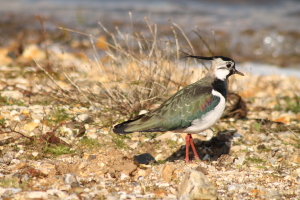Northern Lapwing (Vanellus vanellus)
When a male Lapwing is wrapped up in its song-flight, diving and rolling wildly in the sky and making mewing, squealing sounds, it can have the look of a bird exuberantly out of control. But in reality it is more like a dancer, following definite, specific routines choreographed in advance and common to all Lapwings. As it performs all eyes are upon it and it is being judged and marked, metaphorically, by an audience of rival males and potential mates.
The full display begins with a gradually ascending flight low to the ground powered by deep, slow wing-beats, the so-called “Butterfly Flight”. If a female is watching intently the display may end here, but usually the bird suddenly accelerates into the next part of its routine, the so-called “Alternating Flight”, in which the acrobat flies forward rapidly, rolling its body from side to side like a boat caught in a storm, and with wings throbbing. After this it will change tack, making several brief ascents followed by dives, and to make this section more interesting it will sometimes flip over on its back in mid air. A relatively normal level “Low Flight” follows, taking the bird 10-50m forwards without doing anything spectacular, but this abruptly ceases as the bird increases the speed of its wing-beats and gains height quickly, introducing loud calls that sound a little bit like a yodel. Having reached the top of its ascent the Lapwing maintains its High Flight and accompanies it with excited “weep weep!” calls. Finally the bird plunges dramatically towards the ground in a Vertical Dive, sometimes turning over completely as it does so, and makes a sound somewhat like the peeling of Sellotape. It levels off in an Alternating Flight and lands.
Naturally, some males perform their routines better than others and, although most males are monogamous, some will attract two females to nest within their defended territory. Most females strive to prevent this happening, however, acting very aggressively towards any of their gender that might dare to breach their borders. They do not wish to compromise the male’s paternal assistance. The relationship between paired birds lasts only for a season, but both contribute to incubation and looking after the chicks, and this often includes distraction displays and the harassment of marauding predators.
The Lapwing is a bird of open pastureland, and is one of the few waders that breeds over almost all of Europe, from the sub-Arctic to the Mediterranean fringe. In historical times it has shifted away from natural habitats to colonise agricultural land. It not only breeds on farmland but winters there, too, feeding on soil invertebrates such as insect larvae and worms.
Lapwings are only short-distance migrants; their very rounded wings are not suitable for long flights, so they tend to remain within Europe in winter, perhaps popping over to North Africa at the very most. Being dependent on feeding in moist soil they are extremely vulnerable to frost and snow, so the moment conditions deteriorate they are hastened away to warmer and wetter climates.

